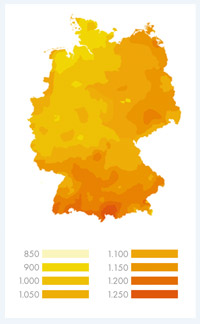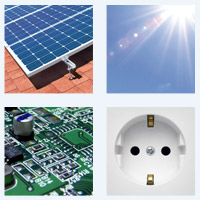How to!
Photovoltaics simply explained
Photovoltaics - what is it?
The sun provides life on our planet - and provides us with the energy we need in order to be well-equipped for the future. How can photovoltaics make a contribution?
Photovoltaics stands for the direct conversion of sunlight into electrical energy. This is where the "photovoltaic effect" becomes important: The light falls on the solar module and unleashes electrical charge in the process. For this purpose, silicon built into the module as a semiconductor material is responsible by becoming conductive through the solar radiation built into the module. The base material of silicon itself is special sand.
Photovoltaics is not a new invention. Already in the 50s of the last century it was used in the space technology and remained to be an integral part until today.
The steady ongoing development led to the fact that solar modules were always getting cheaper, at the same time the operation of solar energy systems also became more profitable. And so more and more owners of PV installations make themselves independent - from rising power prices back to the in-house energy generation plant on site.
It is no coincidence the "photovoltaics" reminds one of "photographing". Both terms contain the Greek word "photos" for "light". The second part comes from "volt", the unit for electrical voltage. The common abbreviation is PV.
How does sunlight become power?

Even if the sun does not shine visibly in the sky and is obscured by clouds, it still sends us its light - free and every day. Unlike, for example coal, the sunlight is available indefinitely and is environmentally friendly.
"PV will not be effective here. Here we have far too little sunshine", a widely held opinion, which is not correct at all. Then how often the sun shines and how strong is irrelevant. Or, in other words: The main issue is that light should fall on the the solar modules. Consequently, also at our latitudes we can still "harvest" sufficient sunlight and even during overcast skies the PV system will function without problems.
For the conversion of sunlight so-called semi-conductor materials are used. For this purpose, the already mentioned silicon, but also cadmium telluride, copper indium gallium diselenide or also compounds from copper-indium and selenite. Silicon is still the major raw material for the production of the so-called wafer from which the solar cells are made. To generate electricity, the semiconductor material are displaced by chemical elements. This produces a positive and a negatively charged semiconductor layer. Where the layers meet, an electric field is built up by the solar radiation. This can then be used to generate electricity.
Today more and more PV facilities are established that are equipped with temporary energy storage devices. In this way, the generated electricity from the roof can be used by the consumer downstairs - a further step toward energy independence.